Our official English website, www.x-mol.net, welcomes your
feedback! (Note: you will need to create a separate account there.)
A molecularly distinct subset of glioblastoma requires serum-containing media to establish sustainable bona fide glioblastoma stem cell cultures.
Glia ( IF 5.4 ) Pub Date : 2019-12-23 , DOI: 10.1002/glia.23773 Naga Prathyusha Maturi 1 , E-Jean Tan 1 , Yuan Xie 1 , Anders Sundström 1 , Tobias Bergström 1 , Yiwen Jiang 1 , Lene Uhrbom 1
Glia ( IF 5.4 ) Pub Date : 2019-12-23 , DOI: 10.1002/glia.23773 Naga Prathyusha Maturi 1 , E-Jean Tan 1 , Yuan Xie 1 , Anders Sundström 1 , Tobias Bergström 1 , Yiwen Jiang 1 , Lene Uhrbom 1
Affiliation

|
Glioblastoma (GBM) is the most frequent and deadly primary malignant brain tumor. Hallmarks are extensive intra-tumor and inter-tumor heterogeneity and highly invasive growth, which provide great challenges for treatment. Efficient therapy is lacking and the majority of patients survive less than 1 year from diagnosis. GBM progression and recurrence is caused by treatment-resistant glioblastoma stem cells (GSCs). GSC cultures are considered important models in target identification and drug screening studies. The current state-of-the-art method, to isolate and maintain GSC cultures that faithfully mimic the primary tumor, is to use serum-free (SF) media conditions developed for neural stem cells (NSCs). Here we have investigated the outcome of explanting 218 consecutively collected GBM patient samples under both SF and standard, serum-containing media conditions. The frequency of maintainable SF cultures (SFCs) was most successful, but for a subgroup of GBM specimens, a viable culture could only be established in serum-containing media, called exclusive serum culture (ESC). ESCs expressed nestin and SOX2, and displayed all functional characteristics of a GSC, that is, extended proliferation, sustained self-renewal and orthotopic tumor initiation. Once adapted to the in vitro milieu they were also sustainable in SF media. Molecular analyses showed that ESCs formed a discrete group that was most related to the mesenchymal GBM subtype. This distinct subgroup of GBM that would have evaded modeling in SF conditions only provide unique cell models of GBM inter-tumor heterogeneity.
中文翻译:

分子上不同的胶质母细胞瘤亚群需要含有血清的培养基来建立可持续的真正胶质母细胞瘤干细胞培养物。
胶质母细胞瘤(GBM)是最常见和致命的原发性恶性脑肿瘤。标志是广泛的肿瘤内和肿瘤间异质性和高侵袭性生长,这给治疗带来了巨大挑战。缺乏有效的治疗,大多数患者从诊断后存活不到 1 年。GBM 进展和复发是由抗治疗的胶质母细胞瘤干细胞 (GSC) 引起的。GSC 培养物被认为是靶标识别和药物筛选研究中的重要模型。目前最先进的方法是使用为神经干细胞 (NSC) 开发的无血清 (SF) 培养基条件来分离和维持忠实模拟原发肿瘤的 GSC 培养物。在这里,我们研究了在 SF 和标准下移植 218 个连续收集的 GBM 患者样本的结果,含血清培养基条件。可维持 SF 培养 (SFC) 的频率是最成功的,但对于 GBM 标本的一个亚组,只能在含有血清的培养基中建立可行的培养,称为独家血清培养 (ESC)。ESC 表达巢蛋白和 SOX2,并显示出 GSC 的所有功能特征,即扩展增殖、持续自我更新和原位肿瘤起始。一旦适应了体外环境,它们在 SF 培养基中也是可持续的。分子分析表明,胚胎干细胞形成了一个与间充质 GBM 亚型最相关的离散组。这种独特的 GBM 亚组在 SF 条件下会逃避建模,仅提供了 GBM 肿瘤间异质性的独特细胞模型。但是对于 GBM 标本的一个亚组,只能在含有血清的培养基中建立可行的培养物,称为独家血清培养 (ESC)。ESC 表达巢蛋白和 SOX2,并显示出 GSC 的所有功能特征,即扩展增殖、持续自我更新和原位肿瘤起始。一旦适应了体外环境,它们在 SF 培养基中也是可持续的。分子分析表明,胚胎干细胞形成了一个与间充质 GBM 亚型最相关的离散组。这种独特的 GBM 亚组在 SF 条件下会逃避建模,仅提供了 GBM 肿瘤间异质性的独特细胞模型。但是对于 GBM 标本的一个亚组,只能在含有血清的培养基中建立可行的培养物,称为独家血清培养 (ESC)。ESC 表达巢蛋白和 SOX2,并显示出 GSC 的所有功能特征,即扩展增殖、持续自我更新和原位肿瘤起始。一旦适应了体外环境,它们在 SF 培养基中也是可持续的。分子分析表明,胚胎干细胞形成了一个与间充质 GBM 亚型最相关的离散组。这个独特的 GBM 亚组在 SF 条件下会逃避建模,仅提供了 GBM 肿瘤间异质性的独特细胞模型。并显示出 GSC 的所有功能特征,即扩展增殖、持续自我更新和原位肿瘤起始。一旦适应了体外环境,它们在 SF 培养基中也是可持续的。分子分析表明,胚胎干细胞形成了一个与间充质 GBM 亚型最相关的离散组。这种独特的 GBM 亚组在 SF 条件下会逃避建模,仅提供了 GBM 肿瘤间异质性的独特细胞模型。并显示出 GSC 的所有功能特征,即扩展增殖、持续自我更新和原位肿瘤起始。一旦适应了体外环境,它们在 SF 培养基中也是可持续的。分子分析表明,胚胎干细胞形成了一个与间充质 GBM 亚型最相关的离散组。这种独特的 GBM 亚组在 SF 条件下会逃避建模,仅提供了 GBM 肿瘤间异质性的独特细胞模型。
更新日期:2019-12-23
中文翻译:

分子上不同的胶质母细胞瘤亚群需要含有血清的培养基来建立可持续的真正胶质母细胞瘤干细胞培养物。
胶质母细胞瘤(GBM)是最常见和致命的原发性恶性脑肿瘤。标志是广泛的肿瘤内和肿瘤间异质性和高侵袭性生长,这给治疗带来了巨大挑战。缺乏有效的治疗,大多数患者从诊断后存活不到 1 年。GBM 进展和复发是由抗治疗的胶质母细胞瘤干细胞 (GSC) 引起的。GSC 培养物被认为是靶标识别和药物筛选研究中的重要模型。目前最先进的方法是使用为神经干细胞 (NSC) 开发的无血清 (SF) 培养基条件来分离和维持忠实模拟原发肿瘤的 GSC 培养物。在这里,我们研究了在 SF 和标准下移植 218 个连续收集的 GBM 患者样本的结果,含血清培养基条件。可维持 SF 培养 (SFC) 的频率是最成功的,但对于 GBM 标本的一个亚组,只能在含有血清的培养基中建立可行的培养,称为独家血清培养 (ESC)。ESC 表达巢蛋白和 SOX2,并显示出 GSC 的所有功能特征,即扩展增殖、持续自我更新和原位肿瘤起始。一旦适应了体外环境,它们在 SF 培养基中也是可持续的。分子分析表明,胚胎干细胞形成了一个与间充质 GBM 亚型最相关的离散组。这种独特的 GBM 亚组在 SF 条件下会逃避建模,仅提供了 GBM 肿瘤间异质性的独特细胞模型。但是对于 GBM 标本的一个亚组,只能在含有血清的培养基中建立可行的培养物,称为独家血清培养 (ESC)。ESC 表达巢蛋白和 SOX2,并显示出 GSC 的所有功能特征,即扩展增殖、持续自我更新和原位肿瘤起始。一旦适应了体外环境,它们在 SF 培养基中也是可持续的。分子分析表明,胚胎干细胞形成了一个与间充质 GBM 亚型最相关的离散组。这种独特的 GBM 亚组在 SF 条件下会逃避建模,仅提供了 GBM 肿瘤间异质性的独特细胞模型。但是对于 GBM 标本的一个亚组,只能在含有血清的培养基中建立可行的培养物,称为独家血清培养 (ESC)。ESC 表达巢蛋白和 SOX2,并显示出 GSC 的所有功能特征,即扩展增殖、持续自我更新和原位肿瘤起始。一旦适应了体外环境,它们在 SF 培养基中也是可持续的。分子分析表明,胚胎干细胞形成了一个与间充质 GBM 亚型最相关的离散组。这个独特的 GBM 亚组在 SF 条件下会逃避建模,仅提供了 GBM 肿瘤间异质性的独特细胞模型。并显示出 GSC 的所有功能特征,即扩展增殖、持续自我更新和原位肿瘤起始。一旦适应了体外环境,它们在 SF 培养基中也是可持续的。分子分析表明,胚胎干细胞形成了一个与间充质 GBM 亚型最相关的离散组。这种独特的 GBM 亚组在 SF 条件下会逃避建模,仅提供了 GBM 肿瘤间异质性的独特细胞模型。并显示出 GSC 的所有功能特征,即扩展增殖、持续自我更新和原位肿瘤起始。一旦适应了体外环境,它们在 SF 培养基中也是可持续的。分子分析表明,胚胎干细胞形成了一个与间充质 GBM 亚型最相关的离散组。这种独特的 GBM 亚组在 SF 条件下会逃避建模,仅提供了 GBM 肿瘤间异质性的独特细胞模型。











































 京公网安备 11010802027423号
京公网安备 11010802027423号